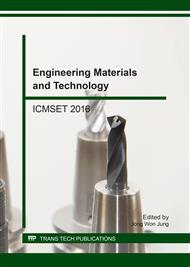[1]
A. Yasmin, J. J. Luo, J. L. Abot, I. M. Daniel, Mechanical and thermal behaviour of clay/epoxy nanocomposites, Compos. Sci. Technol. 66(14) (2006) 2415-2422.
DOI: 10.1016/j.compscitech.2006.03.011
Google Scholar
[2]
M. Liu, B. Guo, M. Du, Y. Lei, D. Jia, Natural inorganic nanotubes reinforced epoxy resin nanocomposites, J. Polymer Res. 15(3) (2008) 205-212.
DOI: 10.1007/s10965-007-9160-4
Google Scholar
[3]
S. Deng, J. Zhang, L. Ye, J. Wu, Toughening epoxies with halloysite nanotubes, Polymer, 49(23) (2008) 5119-5127.
DOI: 10.1016/j.polymer.2008.09.027
Google Scholar
[4]
S. C. Shiu, J. L. Tsai, Characterizing thermal and mechanical properties of graphene/epoxy nanocomposites, Compos. Part B: Eng. 56 (2014) 691-697.
DOI: 10.1016/j.compositesb.2013.09.007
Google Scholar
[5]
J. Zhu, S. Wei, A. Yadav, Z. Guo, Rheological behaviors and electrical conductivity of epoxy resin nanocomposites suspended with in-situ stabilized carbon nanofibers, Polymer, 51(12) (2010) 2643-2651.
DOI: 10.1016/j.polymer.2010.04.019
Google Scholar
[6]
P. Guo, X. Chen, X. Gao, H. Song, H. Shen, Fabrication and mechanical properties of well-dispersed multiwalled carbon nanotubes/epoxy composites, Compos. Sci. Technol. 67(15-16) (2007) 3331-3337.
DOI: 10.1016/j.compscitech.2007.03.026
Google Scholar
[7]
D. Sun, C. C. Chu, H. J. Sue, Simple approach for preparation of epoxy hybrid nanocomposites based on carbon nanotubes and a model clay, Chem. Mater. 22(12) (2010) 3773-3778.
DOI: 10.1021/cm1009306
Google Scholar
[8]
H. J. Kim, D. H. Jung, J. I. Cifuentes, K. Y. Rhee, D. Hui, Enhancement of mechanical properties of aluminium/epoxy composites with silane functionalization of aluminium powder, Compos. Part B: Eng. 43(4) (2012) 1743-1748.
DOI: 10.1016/j.compositesb.2011.12.010
Google Scholar
[9]
M. Sajjad, B. Feichtenschlager, S. Pabisch, J. Svehla, T. Koch, S. Seidler, H. Perterlik, G. Kickelbick, Study of the effect of the concentration, size and surface chemistry of zirconia and silica nanoparticle fillers within an epoxy resin on the bulk properties of the resulting nanocomposites, Polymer Int. 61(2) (2012).
DOI: 10.1002/pi.3183
Google Scholar
[10]
W. Yu, J. Fu, X. Dong, L. Chen, H. Jia, L. Shi, Highly populated and nearly monodispersed nanosilica particles in an organic medium and their epoxy nanocomposites, ACS Appl. Mater. Interf. 5(18) (2013) 8897-8906.
DOI: 10.1021/am402845d
Google Scholar
[11]
D. H. Lee, D. H. Kim, Effects of nano silica and siloxane on properties of epoxy composites for adhesion of micro electronic device, Kor. Chem. Eng. Res. 47(3) (2009) 332-336.
Google Scholar
[12]
J. S. Jang, B. Bouveret, J. Suhr, R. F. Gibson, Combined numerical/experimental investigation of particle diameter and interphase effects on coefficient of thermal expansion of SiO2/epoxy nanocomposites, Polymer Compos. 33(8) (2012) 1415-1423.
DOI: 10.1002/pc.22268
Google Scholar
[13]
E. Bakhshandeh, S. Sobhani, A. Jannesari, A. S. Pakdel, M. G. Sari, M. R. Saeb, Structure-property relationship in epoxy-silica hybrid nanocomposites: The role of organic solvent in achieving silica domains, J. Vinyl Additive Technol. 21(4) (2015).
DOI: 10.1002/vnl.21414
Google Scholar
[14]
A. Afzal, H. M. Siddiqi, A comprehensive study of the bicontinuous epoxy-silica hybrid polymers: I. Synthesis, characterization and glass transition, Polymer 52(6) (2011) 1345-1355.
DOI: 10.1016/j.polymer.2011.01.046
Google Scholar
[15]
S. B. Lee, H. J. Lee, I. K. Hong, Diluent filler particle size effect for thermal stability of epoxy type resin, J. Ind. Eng. Chem. 18(2) (2012) 635-641.
DOI: 10.1016/j.jiec.2011.11.030
Google Scholar
[16]
K. Chen, C. Tian, A. Lu, Q. Zhou, X. Jia, J. Wang, Effect of SiO2 on rheology, morphology, thermal, and mechanical properties of high thermal stable epoxy foam, J. Appl. Polymer 131(7) (2014) 40068.
DOI: 10.1002/app.40068
Google Scholar
[17]
A. Afzal, H. M. Siddiqi, N. Iqbal, Z. Ahmad, The effect of SiO2 filler content and its organic compatibility on thermal stability of epoxy resin, J. Therm. Anal. Calorim. 111(1) (2013) 247-252.
DOI: 10.1007/s10973-012-2267-9
Google Scholar
[18]
H. R. Lee, B. Seo, Preparation and gas permeation properties of silica membranes on porous stainless steel-tube supports, Membr. J. 24(3) (2014) 177-184.
Google Scholar


